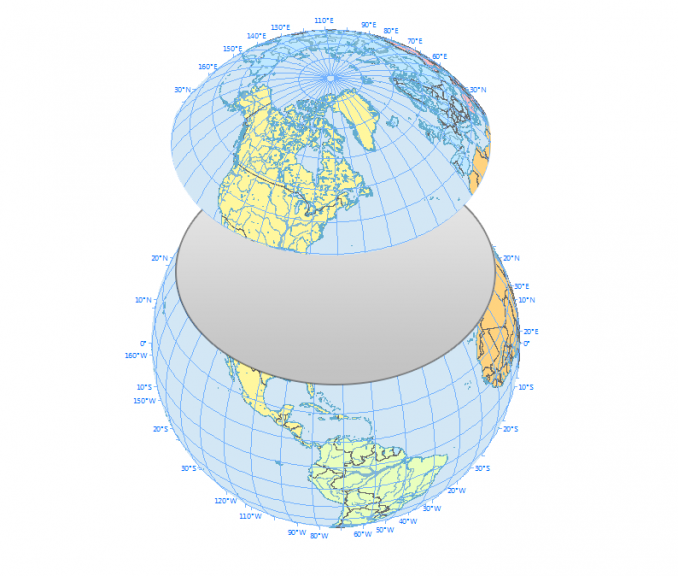Have you ever looked at a flight path on a map and wondered why airplanes take curved routes instead of flying in a straight line? Wouldn’t flying in a direct line be more fuel-efficient and faster? At first glance, it seems logical that a shorter distance would result in less fuel consumption, but in reality, aviation is far more complex.
Several factors determine flight paths, including the Earth’s shape, jet streams, weather conditions, and air traffic regulations. Let’s break down why airplanes rarely fly in a straight line and how their curved paths actually make flights more efficient.
The Earth’s Shape and the Great Circle Route

One of the biggest reasons airplanes don’t fly in a straight line is the Earth’s curvature. While we often view flight maps as flat, the Earth is a sphere, and the shortest path between two points is actually an arc called the Great Circle Route.
If you take a globe and use a string to connect two distant locations, you’ll notice that the shortest route often curves rather than follows a straight path. This is why flights from New York to Tokyo pass over the Arctic region rather than flying directly west across the Pacific Ocean.
Using the Great Circle Route helps planes save both time and fuel, even though it appears curved on a flat map.
Jet Streams and Weather Conditions Impact Flight Paths
Another key factor affecting airplane routes is jet streams—high-altitude wind currents that move at speeds of up to 200 mph (320 km/h). Pilots strategically plan routes to take advantage of these strong winds when possible.
Video : Why Airplanes Don’t Fly Straight
Flying with jet streams allows an airplane to get an extra push, helping it move faster while burning less fuel. Flying against a jet stream can slow down the plane significantly, increasing fuel consumption. Pilots often adjust routes to avoid strong headwinds, even if it means flying a longer distance.
Additionally, storms, turbulence, and severe weather conditions also play a role in determining flight paths. Airplanes may adjust mid-flight to bypass dangerous weather zones, thunderstorms, or areas with extreme turbulence.
Air Traffic Control and Flight Regulations
Air traffic isn’t a free-for-all where planes can just fly wherever they want. There are strict regulations set by aviation authorities and air traffic control (ATC) that dictate flight routes.
Some of these rules include restricted airspace, where certain areas, such as military zones, national security locations, and political zones, prohibit commercial flights from entering. Predefined flight corridors exist to avoid mid-air collisions, ensuring flights follow established air traffic lanes. Major airports handle hundreds of flights daily, so ATC ensures safe and efficient arrivals and departures.
Due to these regulations, airplanes cannot always take the most direct path and must follow designated routes instead.
Avoiding Air Turbulence for Passenger Comfort
Turbulence can make a flight uncomfortable, and pilots actively adjust routes to minimize rough air conditions. There are different types of turbulence, including thermal turbulence caused by warm air rising from the ground. Flying at higher altitudes helps avoid this.

Mechanical turbulence happens near mountains and rough terrains where wind patterns shift unpredictably. Clear-Air Turbulence (CAT) is sudden, strong air currents in high altitudes that are difficult to predict.
To ensure a smoother ride for passengers, pilots may deviate from the shortest path to avoid these turbulent areas.
Why Do Airplanes Sometimes Ascend Before Landing?
If you’ve ever been on a flight where the plane suddenly climbs just before landing, you might have felt a bit concerned. This maneuver is known as a go-around and is actually a common and safe aviation practice.
Some reasons why pilots perform a go-around include runway clearance issues. If another plane hasn’t cleared the runway in time, pilots must abort the landing and circle back. Poor weather conditions, such as poor visibility, strong crosswinds, or sudden gusts, can make a landing unsafe. If a plane is too fast, too high, or not properly aligned with the runway, the pilot will ascend and try again for a safer landing.
Go-arounds are standard procedures in aviation and ensure passenger safety above all else.
The World’s Longest Non-Stop Flight
While most flights follow curved paths, some routes push the limits of non-stop travel. The longest direct commercial flight in the world is from Singapore to Newark, New Jersey, USA.
This flight covers a distance of 10,400 miles (16,700 km) and takes approximately 18 hours and 45 minutes. It follows a carefully optimized path to balance fuel efficiency, wind conditions, and passenger comfort.
Video : Does Earth’s Rotation affect the Airplanes Speed & Flight Time
What Happens If a Plane Suddenly Loses Cabin Pressure?
A sudden drop in cabin pressure is often portrayed as a dramatic event in movies, but in reality, pilots are well-trained to handle it calmly.
When this happens, oxygen masks automatically deploy, and passengers should put them on immediately and breathe normally. The plane will descend to a safe altitude where oxygen levels are sufficient for breathing. The flight crew will assess the situation and communicate with passengers.
Losing cabin pressure doesn’t mean the plane will crash—pilots follow strict safety protocols to handle such incidents efficiently.
Final Thoughts: Why Curved Flight Paths Are More Efficient
While it may seem counterintuitive, airplanes take curved routes instead of straight lines to optimize flight efficiency, fuel usage, and passenger safety. Factors such as the Earth’s shape, jet streams, air traffic control, and weather conditions all play a crucial role in determining flight paths.
So next time you’re on a plane and see the route map displaying a curved flight path, remember there’s a lot of science and planning behind it to ensure you reach your destination as safely and efficiently as possible.
For those who don’t understand this
At the beginning of a relationship, everything feels like a fairytale. Butterflies, compliments, sweet words, and affectionate gestures define the early stages of romance. It’s as if your partner can do no wrong, and every conversation is filled with warmth and tenderness.
But fast forward a few years, and things change. The sweet sugar of new love turns into something a little more… let’s say, citrusy. Those once-soft words might now include playful sarcasm, teasing, and brutally honest remarks. Does this mean love has faded? Absolutely not!
For those who don’t understand, this shift is actually a sign of real love—a transition from the excitement of something new to the comfort of something strong. Let’s break it down.
New Love: When Everything is Sugar and Spice

When love is new, girls (and guys too) tend to speak in the sweetest way possible.
✔ They compliment everything from your smile to the way you tie your shoes.
✔ They say good morning texts like they’re writing poetry.
✔ They laugh at all your jokes, even the bad ones.
✔ They use soft, gentle tones, always trying to be the best version of themselves.
This stage is exciting, passionate, and full of sweetness, just like sugar. It’s a time when both partners put in extra effort to impress each other and avoid conflicts at all costs.
But here’s the reality: this phase doesn’t last forever—and that’s not a bad thing.
Long Love: When Things Get More… ‘Lime-Flavored’
As the relationship matures, the sugar-coating starts to wear off. This doesn’t mean the love is gone—it just means both partners are now comfortable enough to be their real selves.
Video : What Does A Women Feel When You Walk Away?
✔ Less sugar, more spice: Instead of constant compliments, you now get teasing, playful sarcasm, and inside jokes.
✔ Honest communication: She won’t pretend to love your bad haircut—she’ll straight-up tell you to fix it.
✔ More “tough love”: If you’re slacking on something, she won’t hesitate to call you out on it—but always with love.
✔ Teasing replaces flattery: Instead of saying, “You’re so handsome,” she might say, “You really think that outfit matches? Cute.”
At first, it may seem like she’s become “mean”, but the truth is, she’s just comfortable enough to be 100% real with you.
Why This Change is a Good Thing
Many people panic when they notice their partner doesn’t act the same as they did in the early days. But this change isn’t bad—it’s actually proof that the relationship has entered a deeper stage of love.
Here’s why:
✔ Comfort = Authenticity – She’s not trying to impress you anymore; she’s just being herself. That means the love is real, not a performance.
✔ Teasing = Affection – Playful sarcasm is often a sign of deep emotional connection. The fact that she feels safe enough to joke around with you means she trusts you.
✔ Honesty = Growth – She’s no longer telling you what you want to hear; she’s telling you what you need to hear, helping you become the best version of yourself.

Think of it like this: sugar tastes great, but too much of it is unhealthy. A little lime, though? It keeps things fresh and exciting!
Signs That Your Relationship Has Transitioned from Sugar to Citrus (And That’s Okay!)
1. The compliments slow down, but the actions speak louder
She may not say “you’re so amazing” as often, but she’ll show love in other ways—by supporting your goals, remembering the little things you like, and sticking with you through tough times.
2. There’s more teasing, but it’s all love
Instead of praising every single thing you do, she now teases you—but in a way that brings you closer.
3. She tells you the truth, even when it’s not what you want to hear
If she cares about you, she won’t let you walk around with bad fashion choices or a dumb idea. She’ll call you out, but only because she wants the best for you.
4. “Good morning” texts turn into “Don’t forget to pay that bill”
It may seem less romantic, but it’s a sign that she’s thinking about your life together, not just the honeymoon phase.
Video : 7 things women do when they genuinely love you
What to Do When the Sweetness Fades
Instead of worrying, embrace it! This phase of love is where real connection and long-term happiness are built. Here’s how to keep things fun and balanced:
✔ Appreciate her honesty – It’s a sign she sees you as a life partner, not just a crush.
✔ Keep the romance alive – Just because the sugar phase fades doesn’t mean you should stop making her feel special. Small gestures still matter!
✔ Laugh together – Don’t take the teasing too seriously. If she roasts you, roast her back (lovingly, of course!).
Final Thoughts: Love Evolves, and That’s Beautiful
At the end of the day, sugar is sweet, but citrus is refreshing. A long-term relationship isn’t about staying in the honeymoon phase forever—it’s about growing together, becoming each other’s best friend, and loving in a deeper, more authentic way.
So, the next time you notice your partner switching from sugar to lime, don’t worry—it just means the love is getting real. And that’s something to celebrate!
What do you think? Have you experienced this shift in love? Drop a comment and let’s talk!



Leave a Reply